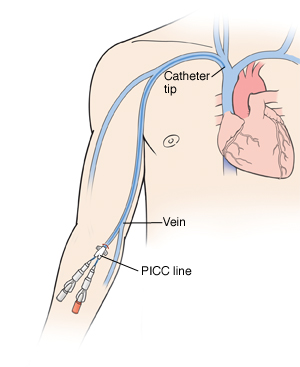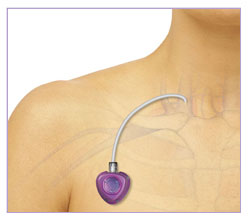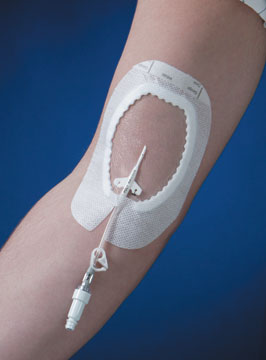Ever wanted an IV directly to the Jugular?
Of course you have.
In trying to provide as comprehensive of a history on this whole saga as possible I somehow forgot to include the story of my "Port" install. I guess you could the say the reason I forgot is that I now take the port for granted, using it every time I have a chemo session or need a blood draw for lab workups. It's easy to forget about but it is a major convenience and everyday part of treatment.
So what is the Port? Well, according to the company that created it, the PowerPort® Implantable Port Device is:
Lightweight for Patient Comfort (Can confirm)
Easily Identifiable (More on that in a moment)
Power Injectable! (It's called a power port for a reason. Strap yourself in!)
Titanium Port Body (okay, so their web designer isn't an English Major)
So what does all this mean? When you're facing the prospect of being injected with an IV drip daily for a week or more, efficiency and limiting needle punctures becomes medically advisable. Also, you don't want to look like a heroin addict, so the options are do the port install, have a semi-permanent PICC catheter installed in your arm or, just start a new IV every day which will give you the arms of early year 2000s Courtney Love. As I understand it, medically speaking, it's really only option one or two here because heroin chic went away with the 90s [citation needed].
So let's compare the two options before we get into the nitty gritty of the Port.


The PICC Catheter:
Semi-permanent install into the arm vein
Dangles out from your arm
Must cover with plastic during showers like a savage
The PowerPort:
Surgically installed under skin
Turns you into a cyborg
Can shower like a normal human
It might not be obvious given these vague images and descriptions but there is a huge downside to the PICC Catheter option: the ends of it are exposed and require constant attention. For example, with the PICC, you have to wrap it in plastic (i.e. Glad Press and Seal) if you plan on taking a shower ever. You also potentially need to tape it down so its not flopping all over the place. Let's take a break for a second to ask ourselves a question: Does cancer sound fun yet?
Honestly, for my part, the answer isn't as obvious as you might think. Does it suck I have to go through this? Yeah, but it's happening. Soo... on the plus side the medical technology at play here is really quite incredible and totally fascinating for the dweeb in me (Editor's note: my Dweeb-cell tumor is also being treated by the chemotherapy).
PowerPort: Don't you wish your boyfriend was hawt like me?
The "PowerPort" or "Port" for short seems to be a vastly superior option here as far as temporary implantable devices go. It has made everything easier for this process from blood draws to actual administration of the chemo drugs. But how does it work?!? You might be thinking like the selfish, voyeuristic blog reader you are. Don't worry, baby birds, I'll feed you.
The Port is a pretty neat combination of plastics, titanium, silicone and -- I think -- fairy wings. Pictured above and here, it's a relatively small little device with a couple grooves over a silicone membrane.
Finding the Power Port: Don't you wish your boyfriend was a freak like me? Dontcha?
When getting an injection or drawing blood, the technician can feel for the three grooves beneath the skin to target the needle entry easily in between them. The device is flushed with a saline solution and then anti-clotting agent before treatment is administered. Because of the devices makeup, it is safe for most imaging scans (i.e. MRI and CT) which will be needed for follow up coming out of treatment. All told, it saves time, energy and cuts down on infection potential.
The install of the port itself was a fairly straight forward, outpatient procedure. It was a little strange though since the numbing agent they use is local (i.e. on the skin) and the anesthesia is a minor "waking" anesthesia. Over the course of the 40 minute long procedure, I think I fell asleep once or twice but was awake for most of it. Generally speaking, it felt like being poked and pulled and pushed by a nonspecific manipulating digit. Let your mind run with that one. The port is generally installed for the duration of treatment and short time after depending on need.
Once treatment is over and you don't need to get stabbed with a needle every 24 hours, the device will be removed via a quick outpatient procedure. We should talk about two recommendations I have, though: 1) Keep the port until after you go on a celebratory bender when treatment is over, it will make administering IV Fluids easy to prevent hangovers; 2) Keep the port in a trophy case, you have earned it.
Next we start with the Chemo. It’ll be fun, I promise?
-- Post Script --
I'd like to take a second to thank you for reading. Most of these posts are emotionally draining to write so I don't take the time to edit them because I'm not in english class anymore, Dallas! They are ultimately enjoyable and cathartic to write, however. It's like taking you on this journey with me and the resulting outpouring of love and support has been very uplifting.
To that end, I've setup easier ways to follow the blog than just checking to see if I have the energy to write. You can now subscribe for e-mail updates every time there's a post or follow my twitter account which will post all new blog posts. You can use the buttons below. I might add them to the footer going forward to make it easier.
Thanks again, people!



















